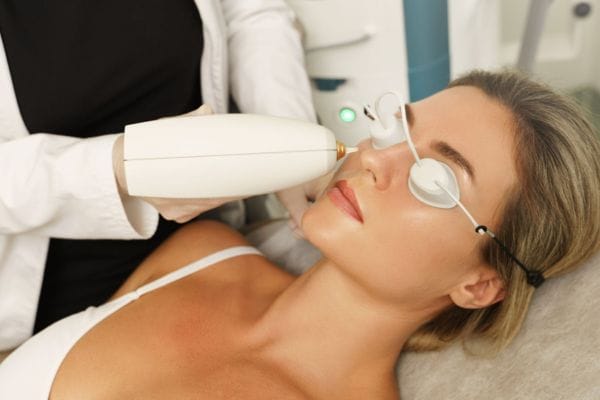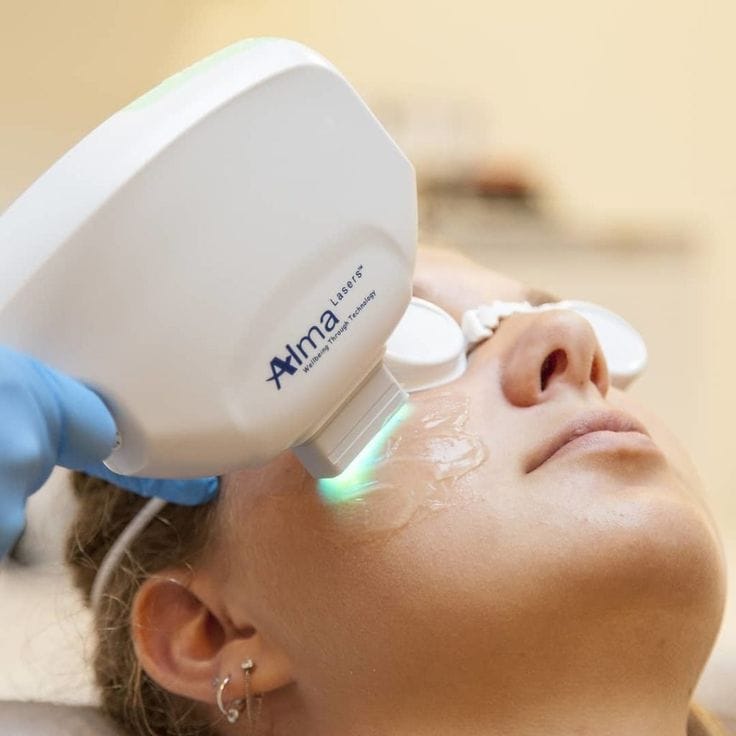In the world of non-invasive cosmetic procedures, Intense Pulsed Light Therapy (IPL) stands out as a versatile treatment option for a wide range of skin issues. Whether you’re battling rosacea, acne scars, or age spots, IPL treatment is considered an effective method using a broad spectrum of light. Unlike a laser, which uses one wavelength of light, IPL emits light pulses of various wavelengths that can target several skin conditions at once. This guide dives into what makes IPL unique and how it compares to other options like laser therapy.
What is Intense Pulsed Light Therapy?
Intense Pulsed Light (IPL) therapy is a non-invasive cosmetic procedure that uses a broad spectrum of light to target various skin concerns. Unlike lasers that emit a single wavelength, IPL delivers multiple wavelengths, allowing it to address multiple skin issues simultaneously. This versatility makes IPL suitable for treating conditions like sun damage, age spots, freckles, and vascular lesions. The light energy penetrates the skin, targeting pigment-producing cells or hemoglobin in blood vessels, breaking them down, and promoting natural healing processes.
Did you know?
IPL therapy can effectively reduce signs of photoaging, including sunspots and fine lines, by stimulating collagen production.
How does IPL work?
IPL works by emitting pulses of broad-spectrum light that penetrate the skin and are absorbed by specific targets like melanin in pigmented lesions or hemoglobin in blood vessels. This absorption converts light energy into heat, destroying the targeted cells while leaving surrounding tissues unharmed. The body’s natural processes then remove these damaged cells, resulting in clearer skin. The treatment is customizable, with filters used to adjust the wavelength, allowing for precise targeting of various skin concerns.
What are the effects of intense pulsed light?
The effects of IPL therapy include improved skin texture and tone, reduction of pigmentation issues like age spots and freckles, and diminished appearance of vascular lesions such as spider veins. Patients often notice a more even complexion and a youthful glow. Additionally, IPL can stimulate collagen production, leading to firmer skin over time. Multiple sessions are typically required for optimal results, with improvements becoming more noticeable after each treatment.
Did you know?
Unlike lasers, IPL uses multiple wavelengths, enabling it to treat a broader range of skin issues in a single session.
What conditions can be treated with IPL?
IPL therapy is versatile and can treat a variety of skin conditions, including:
- Acne and Acne Scars: Reduces inflammation and targets bacteria causing acne.
- Rosacea: Minimizes redness and visible blood vessels.
- Hyperpigmentation: Lightens age spots, sun spots, and melasma.
- Vascular Lesions: Treats spider veins and broken capillaries.
- Unwanted Hair: Targets hair follicles to reduce hair growth.
- Photoaging: Improves skin texture and reduces fine lines.
It’s important to consult with a qualified professional to determine if IPL is suitable for your specific skin concerns.
Benefits of IPL Treatment

The benefits of IPL treatment include:
- Non-Invasive: No need for surgery or injections.
- Minimal Downtime: Most patients resume normal activities immediately.
- Versatility: Treats multiple skin issues simultaneously.
- Customizable: Adjustable settings for different skin types and concerns.
- Long-Lasting Results: With proper care, results can last for several months.
Patients appreciate the convenience and effectiveness of IPL, making it a popular choice for skin rejuvenation
Did you know?
IPL treatments can lead to a 70% reduction in brown spots and redness caused by sun damage.
What skin conditions can IPL therapy improve?
IPL therapy can improve various skin conditions, such as:
- Sun Damage: Reduces sun spots and uneven pigmentation.
- Freckles: Lightens and diminishes their appearance.
- Fine Lines and Wrinkles: Stimulates collagen for smoother skin.
- Large Pores: Tightens skin and reduces pore size.
- Stretch Marks: Improves texture and color.
Regular sessions can lead to significant improvements in skin appearance and health.
How effective is intense pulsed light therapy for rosacea?
IPL therapy is effective in managing rosacea symptoms by targeting and reducing visible blood vessels and redness. The light energy coagulates the blood vessels, which are then absorbed by the body, leading to a clearer complexion. Multiple sessions may be necessary, and maintenance treatments can help sustain results. Patients often experience a significant reduction in flushing and improved skin tone.
Can IPL help with acne and age spots?
Yes, IPL can help with both acne and age spots. For acne, IPL targets the bacteria responsible for breakouts and reduces inflammation, leading to fewer pimples and clearer skin. It also helps fade post-acne pigmentation. Regarding age spots, IPL breaks down excess melanin, lightening dark spots and evening out skin tone. Consistent treatments yield the best results.
IPL Procedure: What to Expect
During an IPL procedure:
- Preparation: The skin is cleansed, and a cooling gel is applied.
- Protection: Patients wear protective eyewear to shield their eyes.
- Treatment: A handheld device delivers light pulses to the targeted areas.
- Sensation: Patients may feel a mild snapping sensation, similar to a rubber band.
- Duration: Sessions typically last 20-30 minutes, depending on the treatment area.
Post-treatment, patients might experience slight redness or swelling, which subsides within a few hours
What does an IPL treatment session involve?
An IPL treatment session involves:
- Consultation: Discussing skin concerns and goals with a specialist.
- Skin Assessment: Evaluating skin type and condition to customize settings.
- Procedure: Applying light pulses to the skin using a specialized device.
- Aftercare: Providing guidelines to care for the treated area, including sun protection.
Multiple sessions, spaced about a month apart, are often recommended for optimal results.
Is IPL treatment safe for all skin types, including Fitzpatrick skin types?
IPL treatment is generally safe for Fitzpatrick skin types I to III (lighter skin tones). However, caution is advised for types IV to VI (darker skin tones) due to a higher risk of pigmentation changes. It’s crucial to consult with a qualified practitioner who can assess your skin type and determine the appropriate settings to minimize risks.
How to prepare for an intense pulsed light procedure?
Preparation steps include:
- Avoid Sun Exposure: Stay out of the sun and avoid tanning for at least two weeks prior.
- Discontinue Certain Products: Stop using retinoids and exfoliants a few days before treatment.
- Clean Skin: Ensure the treatment area is clean and free of makeup or lotions.
- Medications: Inform your provider about any medications you’re taking, as some can increase sensitivity.
Following these steps helps ensure a safe and effective treatment
Comparing IPL and Laser Treatments

Differences:
- Light Spectrum: IPL uses multiple wavelengths; lasers use a single, focused wavelength.
- Treatment Area: IPL covers larger areas; lasers are more precise.
- Skin Concerns: IPL is versatile; lasers are often used for specific issues.
Which is Better?
The choice depends on individual skin concerns and goals. IPL is ideal for general skin rejuvenation, while lasers may be better for targeted treatments like tattoo removal.
Pros and Cons:
- IPL Pros: Versatile, minimal downtime, treats multiple issues.
- IPL Cons: May require more sessions, less effective on darker skin tones.
- Laser Pros: Precise, fewer sessions needed.
- Laser Cons: More expensive, longer recovery time
Alternatives to IPL Therapy
Alternatives include:
- Chemical Peels: Exfoliate the skin to improve texture and tone.
- Microdermabrasion: Removes the outer layer of skin for a smoother appearance.
- Laser Resurfacing: Targets deeper skin layers for more significant results.
- Radiofrequency Treatments: Use energy to stimulate collagen production.
Each alternative has its benefits and is suitable for different skin concerns
Post-Treatment Care and Considerations
After an IPL session:
- Sun Protection: Apply sunscreen with at least SPF 30 daily.
- Gentle Skincare: Use mild cleansers and moisturizers.
- Avoid Heat: Steer clear of hot showers, saunas, and intense workouts for 24-48 hours.
- Monitor Skin: Watch for any adverse reactions and contact your provider if needed.
Proper aftercare enhances results and minimizes potential side effects.
Frequently Asked Questions about Intense Pulsed Light
Is IPL therapy effective for skin rejuvenation?
Yes, IPL therapy is highly effective for skin rejuvenation because it targets multiple signs of aging. Like fine lines, sun damage, age spots, and uneven skin tone. By delivering broadband light to the epidermis and deeper layers of skin. The light energy is absorbed by pigmented and vascular lesions, helping to stimulate collagen production and improve overall skin texture and tone.
It’s a non-invasive option that many dermatologists recommend as part of regular skin care and cosmetic treatment plans, especially when spaced one month apart for lasting results.
What is intense pulsed light used to treat?
Intense pulsed light is used to treat a variety of skin conditions, including vascular and pigmented lesions, fine lines and wrinkles, and unwanted hair, making it a popular non-invasive cosmetic procedure.
What is the downside of IPL?
The downside of IPL may include mild sunburn, redness, and temporary irritation, especially in darker skin tones, though newer IPL devices reduce the risk to surrounding tissue from excess heating.
How much does IPL treatment cost?
IPL treatment may cost between $150 and $400 per treatment session, and multiple IPL sessions spaced about one month apart are often required for optimal results depending on the treatment area.
intense pulsed light therapy dry eye?
Intense pulsed light therapy has shown promise for patients with refractory dry eye and is especially useful in improving dry eye symptoms by enhancing meibomian gland expression through light and meibomian gland stimulation.
does intense pulsed light therapy hurt?
IPL is considered relatively painless, but patients may feel a sensation similar to the snap of a rubber band during pulses of light; wearing dark glasses to protect your eyes is also required during exposure to intense light.
Intense Pulsed Light Therapy offers a versatile and effective solution for various skin concerns, from pigmentation issues to unwanted hair. By understanding the procedure, benefits, and aftercare, individuals can make informed decisions and achieve healthier, more radiant skin. Always consult with a qualified professional to ensure the best outcomes tailored to your unique needs.
Read also about Mascara and Lash Lift